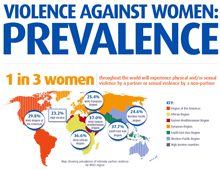 The study highlights the need for all sectors to engage in eliminating tolerance for violence against women and better support for women who experience it.23 June 2013 – The first global report on the worldwide prevalence of violence against women and the serious impact of violence on women’s health was released on 20 June 2013. The report, developed by WHO, the London School of Hygiene and Tropical Medicine and the South African Medical Research Council, presents data on the prevalence of two forms of violence against women: violence by an intimate partner (intimate partner violence) and sexual violence by someone other than a partner (non-partner sexual violence). Evidence clearly shows that women who have experienced intimate partner violence have higher rates of depression, HIV, injury and death, and are more likely to have low birth weight babies, than those who haven’t.
The study highlights the need for all sectors to engage in eliminating tolerance for violence against women and better support for women who experience it.23 June 2013 – The first global report on the worldwide prevalence of violence against women and the serious impact of violence on women’s health was released on 20 June 2013. The report, developed by WHO, the London School of Hygiene and Tropical Medicine and the South African Medical Research Council, presents data on the prevalence of two forms of violence against women: violence by an intimate partner (intimate partner violence) and sexual violence by someone other than a partner (non-partner sexual violence). Evidence clearly shows that women who have experienced intimate partner violence have higher rates of depression, HIV, injury and death, and are more likely to have low birth weight babies, than those who haven’t.
Research on the health effects of non-partner sexual violence is more limited, however this form of violence also has profound implications for the physical, sexual, reproductive, emotional, mental and social well-being of women.
The report highlights the need for the health sector to take more serious steps to respond to violence against women, particularly at key entry points such as antenatal care, and for the training of health care providers to understand the relationship between violence and women’s ill-health.
WHO also released clinical and policy guidelines on the health sector’s response to violence against women, which highlight the need to integrate issues related to violence into clinical training and undergraduate curriculum for health care providers. Health care providers are often the first professional contact for survivors of intimate partner violence or sexual assault and health care providers need to be able to respond appropriately.The guidelines equip health care providers with evidence-based guidance on how to respond to intimate partner and sexual violence and provide guidance to policy-makers to encourage better coordination and funding of services.
With more than one in three women globally reporting having experienced physical and/or sexual partner violence, or sexual violence by a non-partner, violence against women is a global public health problem. It is a major contributing factor to women’s ill-health and limits their participation in society. It is also a violation of women’s basic human rights requiring a stronger response from the health sector as the evidence is unequivocal that exposure to violence is an important determinant of poor health for women.
Related links




